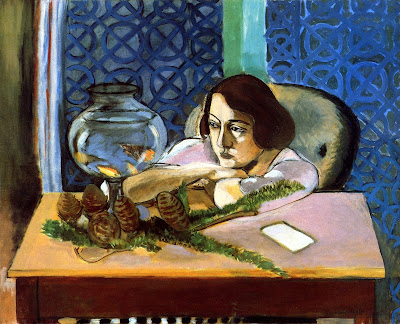32. (French) Fauvism (1898-1954)
“Over a hundred years ago, some French bohemians decreed the purpose of art was to shock the middle classes. It may have been a great idea back then. But these days, the middle classes aren't paying attention. They're all on Jerry Springer or Ricki Lake talking about their cross dressing experiences or sex with the baby-sitter. It's the cutting-edge artists who have to watch in silence and eat their hearts out, complaining about the state of American culture, and demanding even more grant money for more cutting-edge art. In the future, this spectacle of the middle classes shocking the avant-garde will probably become the textbook definition of Postmodernism.” – Brad Holland
What was it about? What were the goals?
The term fauvism, meaning wild and beastly, came from the art critic Louis Vauxcelles, who compared it to a false religion, with Matisse and Derain as the high priests. A better way to see them would be as inventors conducting artistic experiments. These artists were some of the first to explore abstract ways of seeing, finding beauty in abstraction, simplification, and pure color. They typically used large, bold brush strokes, and strong, pure, vibrant colors, coming straight from the tube. It was a flat, bright, and colorful form of early Expressionism, similar to Van Gogh and Gauguin, who were both big influences on the artists. Fauves also studied African and tribal artefacts as art, and not simply anthropological curiosities, and used a lot of that imagery in their work.
The underlying philosophy of the period:
These artists loved color, and found a new way to use it that was more personal, emotional, and intuitive than the Impressionists, with whom they had tired. One can clearly see how they followed the basic idea of Synthetism, combining three concepts of a subject:
1. The outward appearance of the subject.
2. The artist’s personal feelings about the subject (a precursor of Expressionism).
3. Aesthetic principles.
Other than this, though, they painted the same things: portraits, landscapes, and still-lifes.
A bit of historical context:
Strictly speaking, Fauvism as an art movement only lasted from 1904-1908, but the artists associated with it continued working for decades. Many of these artists had the same teacher, the Symbolist Gustave Moreau, who emphasized the beauty of pure colors. Fauvist artists took this to heart, working with strong, bold, pure colors, especially the primaries, red, yellow and blue.
Matisse said of Moreau, “He did not set us on the right roads, but off the roads. He disturbed our complacency.” When Moreau died in 1898, Matisse and Derain took over as leaders of the group. Matisse wrote “Notes of a Painter” in 1908, which was the closest they ever came to a manifesto. Shortly after, the group dissolved.
Although they continued working in the following decades, their styles changed and evolved as they kept on experimenting. They made Fauvism, and then they went on to make new styles and ideas. Metzinger switched to Cubism. Matisse began cutting out colored paper to make collages, his work always in reaction to his rival, Picasso. Derain and Friesz began to paint more realistically, while Rouault never learned how to paint.
How was it represented in the other arts – music, architecture, and literature?
It wasn’t.
Was it great?
I think some of it was. Matisse was the clear leader of the pack. You can see a love and almost nostalgia for everything he painted, in how he represented things with simple lines and colors, even if his work does appear a bit lazy (he worked so quickly and simply). There’s a love for life that shows through in most Fauve artworks. It brings back feelings of optimism that came from early Impressionism. It’s like wave after wave of artists kept saying, “Life is grand, so long as you have a new way to paint.” Some critics complain about lack of skill or that the work is too confusing. But, if you look at their earlier works, many (but not all) of these artists knew how to paint realistically, and were simply experimenting:
Some leading figures:
Pierre Bonnard (1867-1947)
Louis Valtat (1869-1952)
Henri Matisse (1869-1954)
Georges Rouault (1871-1958)
Albert Marquet (1875-1947)
Maurice de Vlaminck (1876-1958)
Raoul Dufy (1877-1953)
Kees van Dongen (1877-1968)
Othon Friesz (1879-1949)
Andre Derain (1880-1954)
Georges Braque (1882-1963)
Some of the most famous artworks of the time:















%20AP.jpeg)








Comments
Post a Comment